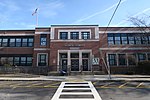Jackson House (Newton, Massachusetts)
1768 establishments in the Province of Massachusetts BayGeorgian architecture in MassachusettsHouses completed in 1768Houses on the National Register of Historic Places in Newton, MassachusettsNewton, Massachusetts Registered Historic Place stubs

The Jackson House is a historic house at 125 Jackson Street in Newton, Massachusetts. The 2+1⁄2-story timber-frame house was built either c. 1768 or c. 1782, and is one of Newton's few surviving 18th-century farmhouses. A house is known to have been on the property c. 1768, but the present house use construction methods and styling more common to a later period in the 18th century, suggesting a c. 1782 construction date. It was restyled in the 1850s to give it Greek Revival features.The house was listed on the National Register of Historic Places in 1986.
Excerpt from the Wikipedia article Jackson House (Newton, Massachusetts) (License: CC BY-SA 3.0, Authors, Images).Jackson House (Newton, Massachusetts)
Cypress Street, Newton Newton Centre
Geographical coordinates (GPS) Address Nearby Places Show on map
Geographical coordinates (GPS)
| Latitude | Longitude |
|---|---|
| N 42.320277777778 ° | E -71.188333333333 ° |
Address
Cypress Street 308
02459 Newton, Newton Centre
Massachusetts, United States
Open on Google Maps










